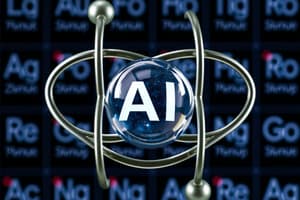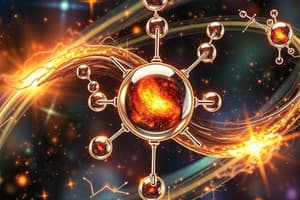Podcast
Questions and Answers
What is an element?
What is an element?
- Substance that cannot be chemically broken down (correct)
- Substance made of two or more atoms
- Smallest part of an atom
- Substance that can be chemically broken down
What is the smallest part of an element that can be identified as that element?
What is the smallest part of an element that can be identified as that element?
atom
What is the center of an atom called?
What is the center of an atom called?
nucleus
What particle has a positive charge?
What particle has a positive charge?
What particle has no charge?
What particle has no charge?
What particle has a negative charge?
What particle has a negative charge?
What does the atomic number represent?
What does the atomic number represent?
What is the total mass of the protons and neutrons in an atom called?
What is the total mass of the protons and neutrons in an atom called?
What is the place in an electron cloud where an electron is most likely to be found called?
What is the place in an electron cloud where an electron is most likely to be found called?
What are the properties of a metal?
What are the properties of a metal?
What element is not shiny and does not conduct electricity well?
What element is not shiny and does not conduct electricity well?
What is the term for elements that make up Group 17 in the periodic table?
What is the term for elements that make up Group 17 in the periodic table?
What is the term for elements that make up Group 18 in the periodic table?
What is the term for elements that make up Group 18 in the periodic table?
What is matter?
What is matter?
What are characteristics used to describe an object called?
What are characteristics used to describe an object called?
What are the four states of matter?
What are the four states of matter?
What state of matter has a definite shape and volume?
What state of matter has a definite shape and volume?
What state of matter has a definite volume but no definite shape?
What state of matter has a definite volume but no definite shape?
What state of matter has no definite shape or volume?
What state of matter has no definite shape or volume?
What state of matter is made of electrically charged particles?
What state of matter is made of electrically charged particles?
What is a chemical formula?
What is a chemical formula?
What is a subscript in a chemical formula?
What is a subscript in a chemical formula?
What is a chemical equation?
What is a chemical equation?
What does a coefficient in a chemical reaction indicate?
What does a coefficient in a chemical reaction indicate?
What process produces new substances with new properties?
What process produces new substances with new properties?
What is a reactant?
What is a reactant?
What is a product?
What is a product?
What is a molecule?
What is a molecule?
What is a chemical bond?
What is a chemical bond?
What change involves a shift from a liquid to a solid?
What change involves a shift from a liquid to a solid?
What change involves a shift from a solid to a liquid?
What change involves a shift from a solid to a liquid?
What change involves a shift from a liquid to a gas?
What change involves a shift from a liquid to a gas?
What change involves a shift from a gas to a liquid?
What change involves a shift from a gas to a liquid?
What change involves a shift from a solid directly to a gas?
What change involves a shift from a solid directly to a gas?
What is a physical change?
What is a physical change?
What is a chemical change?
What is a chemical change?
Flashcards are hidden until you start studying
Study Notes
Elements and Atoms
- An element is a pure substance that cannot be chemically broken down into simpler substances.
- An atom is the smallest unit of an element, identifiable as that element.
Atomic Structure
- The nucleus is the center of an atom, containing protons and neutrons.
- A proton is a positively charged particle located in the nucleus; the atomic number indicates the number of protons.
- A neutron has no charge and is also found in the nucleus; its quantity can be determined by subtracting the atomic number from the atomic mass.
- An electron is a negatively charged particle found in rings outside the nucleus; its number equals the atomic number of the element.
Atomic Properties
- The atomic number represents the number of protons and is equal to the number of electrons in a neutral atom.
- Atomic mass is the total mass of protons and neutrons in an atom.
Energy Levels
- Energy levels refer to the areas in the electron cloud where electrons are most likely to be located, commonly represented by the sequence 2-8-18-32.
Metals and Nonmetals
- Metals possess properties like shiny luster, ductility, and malleability.
- Luster describes how a material reflects light.
- Malleable substances can be shaped when hammered.
- Ductile materials can be stretched into wires.
- Nonmetals tend to be dull, poor conductors of heat and electricity, and are brittle.
Groups in the Periodic Table
- Halogens are found in Group 17 of the periodic table.
- Noble gases occupy Group 18 and are characterized by their lack of reactivity.
Matter and Its States
- Matter is anything with mass that occupies space.
- Properties are characteristics used to describe an object.
- The states of matter include:
- Solid: Has a definite shape and volume.
- Liquid: Has a definite volume but no fixed shape.
- Gas: Lacks both definite shape and volume.
- Plasma: Comprised of charged particles and requires extreme temperatures and pressures.
Chemical Terms
- A chemical formula uses symbols to represent compounds.
- A subscript in a chemical formula indicates the number of atoms of an element in a molecule.
- A chemical equation expresses a chemical reaction using formulas.
- A coefficient denotes the number of molecules involved in a reaction.
Chemical Changes and Reactions
- A chemical reaction results in new substances with different chemical and physical properties.
- Reactants are the starting substances that undergo change.
- Products are the new substances formed as a result of the reaction.
- A molecule is the smallest part of a substance, containing more than one element (e.g., water consists of hydrogen and oxygen).
Types of Changes
- Chemical bonds are forces that hold atoms together in molecules.
- Freezing is the transition from a liquid to a solid.
- Melting is the transition from a solid to a liquid.
- Evaporation occurs when a liquid transforms into a gas at its surface.
- Condensation is the process where a gas changes to a liquid.
- Sublimation involves a solid changing directly into a gas.
- A physical change does not create new substances, while a chemical change results in the formation of new substances.
Studying That Suits You
Use AI to generate personalized quizzes and flashcards to suit your learning preferences.




